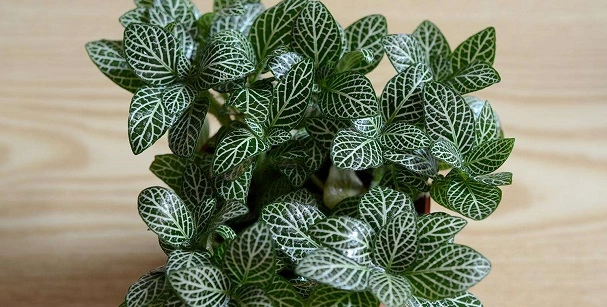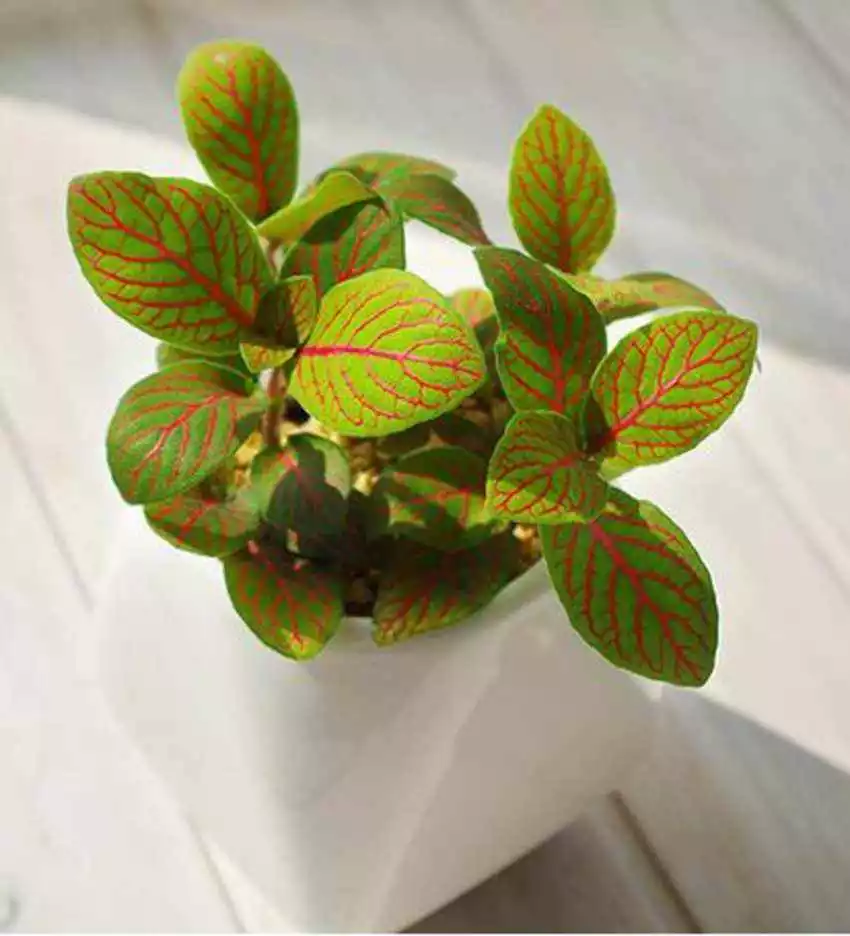How To Save My Nerve Plant Leaves Curling?
Written by Ivy
Dec 27 2021

There are three main reasons for curl of leaf of Nerve Plant. First: it is possible that the leaves of the Nerve Plant are curled due to strong sunlight exposure. Second: it may be that when watering the Nerve Plant, it accidentally poured too much water, resulting in ponding in its basin. At this time, the leaves will curl. Third point: it may be because the growth environment of the Nerve Plant is not suitable, especially the temperature is too high or too low.
Although Nerve Plant likes sunshine, its leaves are prone to curl due to strong sunlight, especially when exposed to the hot sun, which may kill the plant in serious cases. However, if the light is insufficient, the leaf curl of the nerve plant sometimes occurs. Although Nerve Plant has certain shade resistance, if it cannot get light for a long time, it cannot cooperate with light to promote growth. Especially in cold winter, we need to put it outdoors on sunny days to fully receive light.
Read More:
How Much Light Does Nerve Plant Need?
When Nerve Plant is short of water, its leaves will curl, so it is necessary to control the watering amount and let the basin soil be slightly wet. If you don't understand the watering strength, you can use the soil humidity detector to assist watering. Water mist can be properly sprayed during growth to increase air humidity and avoid leaf curling caused by dry air and lack of moisture.
At first, the leaf curl of Nerve Plant will appear. Then, with the aggravation of the situation, Nerve Plant will not only have leaf curl, but also further fall leaves until the plant dies. However, if the plant can not get water supply for a long time or lack of water for a long time, the plant will also have leaf curl due to water shortage. Therefore, we must replenish water in time in the process of maintenance and management, especially in summer. At the same time, we should do a good job in water spraying effect to improve air humidity. In winter, we should strictly control watering or even stop watering to ensure the smooth overwintering of plants and prevent curling of Nerve Plant leaves.
Read More:
How To Water Nerve Plant?
With the growth of Nerve Plant, it will be necessary to change the basin soil regularly, so that larger space and more nutrients are conducive to regeneration. After changing the pot, there will be a pot serving process for about 2 weeks, which is also a process for the root system to adapt to the new pot soil environment. There may also be curling and drooping of the leaves of Nerve Plant. Once the pot serving period is over, the flower can be diluted with nutrient solution and water to strengthen the root system, promote growth and restore the state.
Lighting Exposure
Nerve Plant was originally grown in the tropical rain forest area. Due to its small size, it can only absorb the scattered light leaked from the cracks of tall trees and grow, forming a habit of loving a semi cloudy environment. Therefore, even if we are maintained indoors with poor light, nerve plant can grow normally, but the strong light will burn its leaves and become wrinkled and curled. However, although Nerve Plant is more shade tolerant, plants need light for photosynthesis, so they can't lack light for a long time.Although Nerve Plant likes sunshine, its leaves are prone to curl due to strong sunlight, especially when exposed to the hot sun, which may kill the plant in serious cases. However, if the light is insufficient, the leaf curl of the nerve plant sometimes occurs. Although Nerve Plant has certain shade resistance, if it cannot get light for a long time, it cannot cooperate with light to promote growth. Especially in cold winter, we need to put it outdoors on sunny days to fully receive light.
Read More:
How Much Light Does Nerve Plant Need?
Underwatering Or Overwatering
If the watering amount and frequency are not well controlled, it is easy to cause the curling problem of the leaves of Nerve Plant. Nerve Plant likes high humidity environment. It should be watered more in spring and summer to keep the basin soil moist. However, the root system of Nerve Plant is shallow and weak. Excessive watering will lead to ponding in the basin, causing rotten roots, and the plant will curl, drop or even die.When Nerve Plant is short of water, its leaves will curl, so it is necessary to control the watering amount and let the basin soil be slightly wet. If you don't understand the watering strength, you can use the soil humidity detector to assist watering. Water mist can be properly sprayed during growth to increase air humidity and avoid leaf curling caused by dry air and lack of moisture.
At first, the leaf curl of Nerve Plant will appear. Then, with the aggravation of the situation, Nerve Plant will not only have leaf curl, but also further fall leaves until the plant dies. However, if the plant can not get water supply for a long time or lack of water for a long time, the plant will also have leaf curl due to water shortage. Therefore, we must replenish water in time in the process of maintenance and management, especially in summer. At the same time, we should do a good job in water spraying effect to improve air humidity. In winter, we should strictly control watering or even stop watering to ensure the smooth overwintering of plants and prevent curling of Nerve Plant leaves.
Read More:
How To Water Nerve Plant?

Temperature Stress
Nerve Plant is very sensitive to temperature, and the suitable temperature for growth is 18-24 ℃. In winter, when the temperature is lower than 10 ℃, the growth will stop, and some leaves begin to fall off. If the temperature is lower, it is easy to be frostbitten. When placing the Nerve Plant, we should not move frequently indoors and outdoors, especially in summer, when the plant is exposed to the sun and indoor air conditioning, the plant cannot adapt to the temperature change, and the leaves of the Nerve Plant will curl.Transplanting Problem
For various reasons, we have to move the Nerve Plant flowerpots to other places for maintenance and management. The plants can not adapt to the new environment for a while, and the leaves of Nerve Plant will curl and wither. However, as long as we do well in the later maintenance and management measures, the plant will soon return to normal growth. But sometimes we need to change pots in order to make the plant have more spacious growth space. In this case, the plant will have a slow seedling process in the new pot. During the slow seedling period, the leaf curl and droop of Nerve Plant will also occur due to the problem of transplanting. We only need to manage according to the correct maintenance means to recover, and we don't have to panic.With the growth of Nerve Plant, it will be necessary to change the basin soil regularly, so that larger space and more nutrients are conducive to regeneration. After changing the pot, there will be a pot serving process for about 2 weeks, which is also a process for the root system to adapt to the new pot soil environment. There may also be curling and drooping of the leaves of Nerve Plant. Once the pot serving period is over, the flower can be diluted with nutrient solution and water to strengthen the root system, promote growth and restore the state.
Latest Updated
- Benefits of Bugleweed - 7 Science-backed Health Benefits
- Bugleweed Dangers & Side Effects - Is It Poisonous?
- How to Plant Evergreen Trees - What You Should Know
- When to Plant Evergreens - Grow Guide for Evergreen Trees
- 12 Wonderful Evergreen Shrubs for Your Garden
- 12 Popular Evergreen Plants with Pictures for Beginners
- When And How To Prune A Lilac Bush Like a Pro
- How to Grow & Care for Lilac Vine (Hardenbergia Violacea)
- Japanese Lilac Tree (Syringa Reticulata) Care & Propagation Guide
- Shumard Oak Pros and Cons - What to Know
Popular Articles
- Winter maintenance of Antirrhinum Majus
- How to Grow Terminalia Mantaly Tree
- How to Grow and Care for Crossostephium Chinense
- How to grow Antirrhinum Majus in spring
- Peristeria Elata (Dove Orchid) Profile: Info & Care Guide
- Underwatered Snake Plant (Sansevieria Trifasciata) - Signs And How To Fix
- How to Care for Brazilian Jasmine Plant (Mandevilla Sanderi)
- How to Grow & Care for Graptopetalum Purple Delight in Summer
- Rosa Chinensis (China Rose): Plant Growing & Care Tips
- How to Care for Baby Sun Rose (Aptenia Cordifolia)